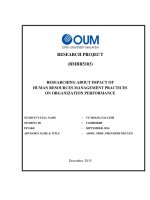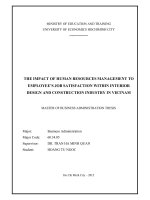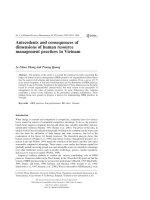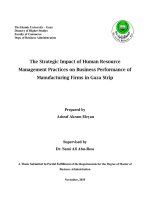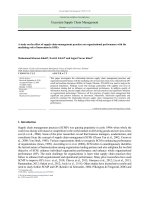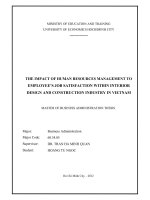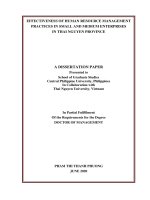The impact of human resource management practices on employee's job satisfaction in Vector Aviation Co., Ltd
Bạn đang xem bản rút gọn của tài liệu. Xem và tải ngay bản đầy đủ của tài liệu tại đây (1.23 MB, 101 trang )
1
TRNG I HC M TP. HCM UNIVERSITE LIBRE DE RUXELLES
HO CHI MINH CITY OPEN UNIVERSITY SOLVAY BRUSSELS SCHOOL
MBAVB3
DUONG THI KIEU CHINH
THE IMPACT OF HUMAN RESOURCE MANAGEMENT
PRACTICES ON EMPLOYEE‟S JOB SATISFACTION
IN VECTOR AVIATION CO., LTD
MASTER PROJECT
MASTER IN BUSINESS ADMINISTRATION
(PART-TIME)
Tutor‟s Name: Dr. VU VIET HANG
Ho Chi Minh City
(2011)
i
DECLARATION
I hereby would like to certify that this work is original and was done by myself. In
certain cases, contributions of others that were involved partially or completely
were quoted clearly with sources presenting in the references list.
The work was performed under the guidance of Dr. VU VIET HANG and followed
the framework of the Master Business Administration program – The join Masters
Program between Ho Chi Minh City Open University (Vietnam) and Solvay
Brussels School (Belgium). The work was completed in February 2011, in Ho Chi
Minh City - Vietnam
(Candidate’s name and signature)
DUONG THI KIEU CHINH
ii
SUPERVISOR’S COMMENTS
As a supervisor for this project, I highly appreciate the working attitude of this candidate.
In consideration of the project’s contents as a whole, I would like to suggest the Board of
Examination to allow this candidate to defend this project.
Ho Chi Minh City, 27 February 2011
Dr. VU VIET HANG
iii
ACKNOWLEDGEMENT
First of all, I would like to express my deepest gratitude and great appreciation to my
supervisor Dr. VU VIET HANG for her valuable guidance, advices and great supports
throughout the research study.
I would like to express my great appreciation to all colleagues in Vector Aviation Co., Ltd.
Deep appreciation and thanks are reserved to Mr. Do Xuan Quang – CEO, Mr Nguyen
Ngoc Nhien – Vice Director for their valued discussions as well as providing me with the
necessary information. Special thanks also to be sent to Ms Van - Head of Human
Resource Department, Mr Duc – Commercial Director, Mr Thanh – RFS department, Mr
Nghia – Business Development Manager and Mr Son – Head of offline sales department
for valuable ideas, advices to complete this research
I would like to express my sincere thanks to all my classmates MBAVB3 for their sharing
with me the knowledge and skills during the challenging courses of this program.
I wish to express my deepest gratitude to all members of my family for their endless
supports, encouragement during my course and this project
Finally, I would like to thank all professors of this program for transmitting the valuable
lectures and thank to the members of the Examination Committee for taking time and
giving valuable comments to improve this study.
HCM City, February 2011
DUONG THI KIEU CHINH
iv
ABSTRACT
For services companies, human resource has been considered as one of the most
valuable assets in the organization. Vector is an aviation services company, and it now is
facing with a big issue that the labor turnover is increase, while the additional well-trained
workforce is severe shortage. This problem is greatly concerned by Vector‟s Board of
Director. They want to know: what kinds of problem does human resource management
(HRM) face with? What do professional employees expect? Do existing employees satisfy
with their job? This research was carried out to provide the comprehensive answers for
those questions of BOD.
The research has three main objectives. Firstly, it identifies various components of
HRM practices which impact on job satisfaction for Vector. Secondly, it tests a model on
the impact of HRM practices to job satisfaction. Finally, it gives some suggestions to
improve HRM practices basing on the findings from the research
Based on the literature review, a proposed research model and hypotheses have
been developed for Vector. Two sets of questionnaire were prepared, one set for qualitative
survey and one set for quantitative survey.
Data from quantitative survey was collected and first used to assess and refine the
measurement scales via exploratory factor analysis. Then, it was used to test the model and
the results were discussed. Data from qualitative study and from documentation were
collected carefully for further analysis and recommendations
The findings of this research investigated a positive link between current HRM
practices and job satisfaction in Vector. This research provides valuable insights of HRM
practices to BOD of Vector understanding key factors impact on job satisfaction
v
TABLE OF CONTENTS
CHAPTER 1: INTRODUCTION 1
1.1 GENERAL BACKGROUND AND STATEMENT OF PROBLEM 1
1.2 RESEARCH OBJECTIVES 2
1.3 SCOPE OF STUDY 3
CHAPTER 2: LITERATURE REVIEW 4
2.1 JOB SATISFACTION THEORIES 4
2.2 THE IMPORTANT ROLE OF HUMAN RESOURCE MANAGEMENT 6
2.3 HUMAN RESOURCE MANAGEMENT PRACTICES 7
2.3.1 Job design 7
2.3.2 Recruitment and selection 8
2.3.3 Appraisal 8
2.3.4 Training and development 9
2.3.5 Compensation 11
2.4 PROPOSED RESEARCH AND HYPOTHESES FOR VECTOR 12
CHAPTER 3: INTRODUCTION TO VECTOR AVIATION 15
3.1 HISTORY OF VECTOR 15
3.2 VECTOR‟S VISION, MISSION & GOALS 16
3.3 CURRENT WORKFORCE AND JOB FAMILY 17
3.3.1 Workforce 17
3.3.2 Job family and its roles 18
CHAPTER 4: RESEARCH METHOD 20
4.1 RESEARCH PROCEDURE 20
4.2 DATA NEEDS 20
4.3 DATA SOURCES 21
4.3.1 Secondary data 21
4.3.2 Primary data 21
4.4 DATA COLLECTION METHOD 22
4.5 MEASUREMENT OF SCALES: 22
4.6 METHOD AND STEPS OF DATA ANALYSIS: 25
CHAPTER 5: DATA ANALYSIS AND FINDINGS 26
5.1 INTERVIEW DATA ANALYSIS AND FINDINGS 26
5.1.1 Data analysis 26
5.1.2 Findings 27
vi
5.2 DATA ANALYSIS FOR THE MAIN SURVEY AND FINDINGS 29
5.2.1 Data analysis 29
5.2.2 Findings from survey 38
CHAPTER 6: DISCUSSION, CONCLUSION AND RECOMMENDATIONS 40
6.1 DISCUSSION 40
6.2 CONCLUSION 43
6.3 RECOMMENDATIONS 44
6.4 LIMITATIONS AND FURTHER RESEARCH DIRECTIONS 51
REFERENCES 53
APPENDICES 57
APPENDIX 1: MODELS OF HRM 57
APPENDIX 2: CURRENT ORGANIZATIONAL STRUCTURE 59
APPENDIX 3: QUESTIONNAIRES FOR INTERVIEW 60
APPENDIX 4: RELIABILITY ANALYSIS 62
APPENDIX 5: ASSESSMENT SUITABLE DATA 68
APPENDIX 6: FACTOR EXTRACTION 70
APPENDIX 7: REGESSION ANNALYSIS 75
APPENDIX 8: SURVEY SUMMARY_VECTOR 79
APPENDIX 9: DESCRIPTIVE REPORT 83
APPENDIX 10: CURRENT JOB DESCRIPTION 86
APPENDIX 11: PROPOSED NEW JOB DESCRIPTION FORM 89
APPENDIX 12: QUESTIONAIRES 91
vii
LIST OF TABLES
Table 3.1 Company‟s performance and market share 15
Table 3.2 Gender structure of employees 17
Table 3.3 Educational background of employees 17
Table 3.4 Recruitment versus resignation in Y‟2010 18
Table 4.1 Summary of scales for 6 constructs 23
Table 5.1 Summary results of reliability analysis 31
Table 5.2 Summary results of assessment suitable data 32
Table 5.3 Rotated Component Matrix (a) 33
Table 5.4 Summary result of factor analysis 34
Table 5.5 Collinearity statistics 35
Table 5.6 Model Summary and statistics significant 36
Table 5.7 Model Summary and statistics significant- extracting ANOVA 37
Table 5.8 Multiple regression result 37
Table 6.1 Suggestion several training course for Vector in 2011 46
Table 6.2 Proposed job analysis process for Vector 49
viii
LIST OF FIGURES
Figure 2.1 Maslow‟s hierarchy of Needs 4
Figure 2.2 Herzberg‟s two-factor theory 5
Figure 3.1 Growth rate in volume (unit: 1,000tons) 16
Figure 3.2 Market share in 2010 16
Figure 5.1 Job position of respondents 29
Figure 5.2 Age of respondents & Educational level of respondents 30
Figure 5.3 Members of year experience & No. of years works for Vector 30
Figure 5.4 Normal Q-Q plot of standardized residual 36
Figure 5.5 Confirmed research model 39
ix
LIST OF ABBREVIATIONS
ABBREVIATION
MEANINGS
HRM
: Human resource management
BOD
: Board of Director
IATA
: International Air Transport Association
FEDAGSA
: Federation of Airline General Sales Agents
TIACA
: The International Air Cargo Association
VIFFAS
: Vietnam Freight Forwarders Association
GSSA
: General Sales and Services Agent
1
CHAPTER 1: INTRODUCTION
This chapter introduces briefly about Vector Aviation Co. Ltd, aviation services industry
and other contents such as statement of problem, research objectives and scopes of study
1.1 GENERAL BACKGROUND AND STATEMENT OF
PROBLEM
Vector Aviation Co., Ltd (Vector) is one of the top three distributors in aviation
services in Vietnam. It provides all range of aviation services including airlines general
sales and services agent (GSSA), feeder services, ground handling services, excess
baggage, aircraft leasing, expressed cargo transportation. Vector‟s clients are logistics
companies who need transport their cargo by aircraft to destinations out of Vietnam
territory.
In Vietnam, aviation services business has been operating for about four or five
year. Before that it was protected and only run by state-owned companies. In 2006,
Vietnam Government issued a new civil aviation law in order to promote the aviation
business and industry growth. This was a golden business opportunity for aviation services
providers in Vietnam. Catching up the said opportunity, Vector was established to enter
into new services business - aviation services. Right from beginning, Vector was
aggressively planning its business activities to cover key area of aviation services such as
acting as general cargo sales agents for many foreign airlines like Malaysia airline,
Scandinavian airline, Etihah Airline, Egypt Airline… For five-year actively operating,
Vector has greatly increased its market share from 1.08% up to around 10% of total cargo
export volume by air from Vietnam.
Most recently, Vietnam Government has signed Air Transport Agreements with 56
countries that created a great variety of potential business opportunities for Airlines and
Agents doing aviation services business in Vietnam. The total loading capacities of
aviation market now increases essentially that can meet the market growing demand which
before was a serious shortage of space. As a consequence that time, most of cargo had
been transported by sea. In the year of 2010, Vietnam was reached over 22% growth in
exports in which air cargo export was growing by 30% versus year 2009.
2
Overall, aviation services market in Vietnam is growing fast and the outlook is
highly potential in future. Vector is now searching for additional professional workforce
that can manage continuing its growth strategy. Personnel, who work in aviation services,
are required to have a sound background in both air logistics and aviation services.
However, this is very new services industry. Therefore, almost of existing universities,
transportation association do not have any appropriate teaching or training programs to
meet the new jobs demand of aviation services. In addition to that, air logistics industry is
also facing the severe shortage of well-trained workforce.
Dealing with the above said problem and in order to well prepare human resources
to meet the growing business trends, BOD of Vector has applied several methods in human
resource management (HRM) such as organizing in-house training courses, oversea
training course; applying sales incentives, allowances, increasing basic salary … However,
there are still some key personnel stopped working and leaving Vector. Within the first
two months of the 2
rd
quarter last year, five key personnel and three senior employees
resigned. By December 2010, the labor turnover rate hit 6%. The reasons why employees
left the company were different from case to case that may be salary, career opportunity,
promotion, appraisal… BOD has greatly concerned so much about current situation of the
company‟s workforce. They want to know and understand what was the root causes that
made some those employees left the company? What do professional employees expect?
What are their needs? Are they satisfied with their current job? What kinds of problem
does HRM face with? To provide comprehensive answers to all above listed questions, the
company has not only conducted the exit interviews collecting comments from resigned
staffs but also the statistical data necessary for analyzing the root causes. That is the
background for why this study is carried out
1.2 RESEARCH OBJECTIVES
In respond to above problem statement, this study will aim to:
To identify key elements of HRM practices which impact on job satisfaction for
VECTOR
To test a model about the impact of HRM practices on employee‟s job satisfaction
To give some suggestions for improving HRM practices based on the key findings
of this study
3
1.3 SCOPE OF STUDY
This study mainly focuses on one dimension of HRM that is HRM practices. And
only 5 key elements in HRM practices model of Guest (1997) are concerned. Other
possible factors are beyond scope of this study
This study focuses on all employees, five resigned people in year 2010. Probation
staffs are not subject of this study.
4
CHAPTER 2: LITERATURE REVIEW
This chapter will introduce some key concepts relating to job satisfaction, HRM practices
such as job analysis, recruitment and selection, performance management, training &
development, compensation. Proposed research model and hypotheses are also to be
presented in this chapter.
2.1 JOB SATISFACTION THEORIES
Job satisfaction refers to the attitude and feeling of people about their work which
determine their work performance (Armstrong, 2006). If employees have positive and
favorable attitudes towards the job, that indicates job satisfaction. Similarly, Robbins and
Judge (2007) viewed job satisfaction as a factor of an employee‟s emotions. Therefore, job
satisfaction will provide people inner motivation and self encouragement. When people
satisfy with the job, they will often have higher productivity than others (Vroom, 1964). So
understanding what should be done to achieve the high performance through people is
always hot subject of all organizations.
Figure 2.1 Maslow’s hierarchy of Needs
(Sources: www.businessbolls.com)
5
Various theories have been constructed in attempt to explain what makes people
satisfied with their job. Among of those theories, two conceptual frameworks have been
concerned to be prominent in review of literature. First is content theory. This theory
explains why human needs change with time and indicates specific factors that motivate
people. Content theory was developed originally by Maslow (1954). He said that people
feel be satisfied when their needs are filled up. Needs, according to Maslow, have been
classified at 5 levels which could be displayed as figure 2.1
Based on the needs theory, Herzberg (1957) then identified a numbers of
fundamental needs. Herzberg defined two group factors of needs that affect on job
satisfaction: motivation and hygiene. Hygiene issue, according to Herzberg, cannot
motivate employee but can minimize the dissatisfaction. It includes salary, working
condition, company policies, supervision and job security. While motivation, in other
hand, creates satisfaction by fulfilling individual‟s needs and growth. It includes the work
itself, achievement, recognition, responsibility, personal growth and advancement.
Herzberg‟s two factor theory has been summarized as following
Figure 2.2 Herzberg’s two-factor theory
Another concept theory is “three-need theory” or acquired-need theory of David
(1958). According to David, the needs of people are influenced by culture background and
life experience. He defined three needs including achievement, affiliation and power. The
important of each of three needs to an individual will vary from one person to another.
People with different needs are motivated differently. In the point of his view, which group
of people having high need for achievement should be given challenging projects with
reachable goals. They should be provided frequently feedback. While money is not an
6
important motivator, it is an effective form of feedback. To people having high need for
affiliation, they need perform best in a cooperative environment. And to people having
high need for power, management should provide power seekers the opportunity to
manage others.
Second is process theory, it attempts to explain job satisfaction through looking at
expectations, goal achievement and feelings about equity. Within this framework, Vroom
(1964), Latham & Locke (1979) and Adams (1965) have become the most prominent
theorists. According to Vroom (1964), expectations are defined as a momentary belief
concerning the likelihood that a particular act will follow by a particular outcome. This
expectancy theory says that individuals have different sets of goals and can be motivated if
they believe that there is a position link between efforts and performance. Favorable
performance will result in desired rewards. Rewards will satisfy a need and satisfied need
is strong enough to make more efforts. Latham & Locke (1979) stated that when individual
are set specific goals and receiving feedback on performance, they feel be satisfied
because of goal achievement. As suggested by Adams (1965), feelings about equity are the
perception of employee having about the fairness with areas such as performance
appraisal, promotion being operated.
Reviewing job satisfaction theories above helps to recognize some key factors that
affect on job satisfaction such as nature of work, pay, achievement, recognition,
performance, personal growth. Those factors are also key elements of HRM practices
which have been mentioned in several models of HRM practices, especially in Guest
model of HRM practices (1997).
2.2 THE IMPORTANT ROLE OF HUMAN RESOURCE
MANAGEMENT
HRM involves all management decisions and practices that directly affect,
influence the people or human resource, who works for the organization (Fisher,
Schoenfeldt and Shaw, 1996). The results of job are created by people, thus it could be
said that people determine the organization outcome (Boselie,2002; Guest,1997; Delery
and Doty, 1996). More and more business leaders nowadays accept that competitive
advantages could be achieved only through the effort and creativity of the people
employed by them (Margaret and Caroline, 2005). Therefore, in order to get the
7
competitive advantage or to increase the firm outcome, the HRM policies and practices
must be considered and done well to satisfy the existing employees, one of important
factors increase employee retention rate.
2.3 HUMAN RESOURCE MANAGEMENT PRACTICES
HRM is composed of the policies and practices that effect employee‟s behavior,
attitude and performance (Noe, Hollenbeck, Gerhart, and Wright, 2007). HRM can be
regarded as a set of interrelated policies with an ideological and philosophical
underpinning (Storey,1989). There are some tops model of HRM such as Fombrun, Tichy
and Devenna model of HRM (1984), Harvard model of HRM (Beer et al,1984), Guest
model of HRM (Guest,1997), Warwick model of HRM(Hendry and Pettigrew,1990) in
appendix-1. Among those models, almost elements of HRM practices in Guest model are
compatible with current HRM practices in Vector. Those are job design, recruitment and
selection, training and development, appraisal, rewards. Those factors are considered to
affect job satisfaction which being reviewed in theory of job satisfaction above except
element “selection”. However, “selection” is a part in “company policies”, while hygiene
factors in Two-factor theory of Herzberg included the factor “company policies”.
Therefore, “selection” will be chosen in proposed research model of this study.
In short, five elements of Vector‟s HRM practices such as job design, recruitment
and selection, training and development, appraisal, rewards are chosen for this study.
Below are reviewing briefly about function, roles of each element
2.3.1 Job design
The functional structure will be built basing on the strategy, goals of firm. Each
function in the structure must be defined clearly in details such as job purpose, job
summary, job duties, skills, knowledge, abilities, reporting line.… Job design or job
analysis aims to produce information for use in recruitment and selection, performance
management, evaluation for training and development. Therefore, job analysis takes an
important role in HRM.
According to McCormick (1979), job design is the process with several steps such
as collecting and recording job information, checking the job information for accuracy,
writing job description based on the information, using the information to determine what
skills, abilities, and knowledge are required on the job. Loher et al. (1985) found that
8
relation between job characteristics and job satisfactions were stronger for employees in
high growth need strength. Job design is the process of determining the specific tasks to be
performed (Mondy and Noe,1996). Job analysis is a systematic process for collecting
information on the important work related all aspects of a job (Ivancevich,2001). Job
design provides for high levels of employees control also increase opportunity for the
development and exercise of skill (Morrision et al, 2005).
Job profile will be written after the job analysis process. It is a combination of two
important terms that are job description and job specification. In which, job description is a
narrative descriptive the activities performed on a job such as job purpose, job summary,
duties, responsible to, responsible for, job area. It also includes information about the
equipment used and the working condition under which the job is performed. Job
specification indicates the specific skills, knowledge, abilities, personal characteristic.
2.3.2 Recruitment and selection
The aim of recruitment and selection is to obtain the qualified employees in order
to satisfy the human resource needs of the company with minimum recruitment cost. The
goal of a personnel recruitment and selection system is to bring into an organization
individuals who will perform well on the job (Fisher, Schoenfeldt and Shaw, 1996). Better
recruitment and selection strategies result in improved organizational outcomes. The more
effectively organizations recruit and select candidates, the more likely they are to hire and
retain satisfied employees. (Sheila and Paul Bernthal,1999). When the company recruits
key individuals who will contribute significantly to value – creating capacity of the firms
is crucial to success (Scarborough and Elias 2002). On the other hand, the poor recruitment
choice can have undesirable result for organization such as higher rate of turnover, reduced
performance effectiveness and work motivation, lowered HRM outcome.
2.3.3 Appraisal
Performance management is a continuous and flexible process for improving
organization performance by developing the performance of individuals and teams. It
aligns individual objectives to organizational objectives. The aim of performance
management is to develop the capacity of people to meet and exceed expectations and to
achieve their full potential to the benefit of themselves and the organization. Importantly,
performance management is concerned with ensuring that the support and guidance people
9
need to develop and improve are readily available. (Michael Amstrong,10
th
). Fletcher
(1993) wrote: “the real concept of performance management is associated with an
approach to creating a shared vision of the purpose and aims of the organization, helping
each employee understand and recognize their part in contributing to them, and in so
doing, manage and enhance the performance of both individuals and the organization”.
Other definitions about performance management are also mentioned by Hartley (1997),
Walters (1995), Fowler (1996) ….which all emphasize the important role of performance
management and why it should replace to performance appraisal in traditional HR
management
Performance management system has parts such as goals setting, performance
appraisal. There are three basis categories of performance appraisal system: trait-based
appraisal system, behavior-based appraisal system and result – based appraisal system
Trait-based appraisal system is used to assess the personal characteristics
of employees such as their ability to make decision, loyalty to the company,
communication skill,
Behavior-based appraisal system is used to consider the behavior of
employees rather their personal traits. Employees are assessed on what they do on
their job. For example, a shy employee may always be shy, a behavior-based
appraisal may point out particular thing that person should do in different way…
Result-based appraisal system may measure the result of work. This
approach deals with bottom-line issue such as how many machines an employee
sold or how much profit they brought to the firm in a month
Using performance appraisal as an employee development tool by providing
feedback on past performance, the managers or supervisors can encourage employee to
perform better in the future by pointing out the strength, weakness and help employees to
identify effective ways to reach important task. The supervisor can use the performance
appraisal data to determine the training needs for employees.
2.3.4 Training and development
Training is the use of systematic and planned instruction activities to promote
learning for employees (Armstrong, 2006), that helps to modify their attitude, knowledge,
skill behavior through learning experience to achieve effective performance in an activity
10
or range of activities (Barrington, 1994). Its results lead to improve customer satisfaction
and reduce need for supervisor and saves cost in the long run (Porter, 2005).
In addition, training is a necessary tool to motivate and inspire employees that how
important their jobs are and what subjects they need to update for improving their
knowledge, skills to perform their jobs (Susan, 2002). Each employee use their updated
knowledge from training will do their job best to contribute good results for company
performance.
Sloman (2003a) expressed about value of training as follows:” Interventions and
activities that are intended to improve knowledge and skills will increasingly focus on the
learner. Emphasis will shift to the individual learner (or team). And he or she will be
encouraged to take more responsibility for his or her learning. Efforts will be made to
develop a climate that supports effective and appropriate learning. Such interventions and
activities will form part of an integrated approach to creating competitive advantage
through people in the organization”.
Training needs can be assessed by analyzing two major human resource areas: the
organization as a whole, and the needs of the individuals. The organization training needs
that means any person joining to company must be trained as standard criteria careless
who they are; while individual training needs is set up to improve knowledge, skills for
individuals. The difference between two types of training program that company can cut
off budget for individual training program in future by putting more criteria in job
description when recruiting employees.
The result of training will help more for development of employees. Because
development is an unfolding process that enables employees to progress from a present
state of understanding and capability to a future state in which higher-level skills,
knowledge and competencies are required (Armstrong, 2006). Harrison (2000) has been
defined about development as: “Learning experiences of any kind, whereby individuals
and groups acquire enhanced knowledge, skills, values or behavior. Its outcomes unfold
through time, rather than immediately, and they tend to be long-lasting‟.
11
2.3.5 Compensation
Once employees have done their job and got appraisal, they expect to be paid.
Thus, compensation is an important factor to impact how and why people choose to work
for one company over others ( Armstrong, 2006)
No standard compensation system is being applied for all organizations. All forms
of pay or rewards going to employees and arising from their employment (Dessler, 2009).
A good compensation system will help organization to gain a competitive advantage and
to achieve its major objectives through its employees. Because good compensation system
will attract and retain skilled employees, encourage them to develop the skill and abilities,
motivate them to perform job effectively. The position of employee in the company
affects the reward structure, and the consequences of the performance on the strategically
formed goals.
Setting up any compensation system, the organization should base on equity
theory. Equity theory was first developed by Adams (1963), who said that equity is the
balance between inputs versus outcomes which an individual brings to a job and receives
from it. Anger is induced by underpayment inequity and guilt is induced with overpayment
equity (Adam,1965). Therefore, payment is the main concern and the cause of equity or
inequity in most cases. In any position, an employee always wants to receive rewards
basing on their contributions and work performance). However, psychological theory
states that the importance of fairness is a basic need for the well being and satisfaction of
employees (Blau,1964). Therefore, building a compensation system, organization must
concern this issue. The underlying assumption being that money can influence behavior
(Parker and Wright, 2001).
There are three elements of equity: internal equity, external equity and individual
equity
Internal equity refers to the relationship among jobs within an organization.
It exists when the pay differentials between different jobs within the firm are
perceived as fair. Usually, higher-level employees will earn more than lower-level
employees.
Individual equity refers to comparisons among individuals in the same job
within an organization.
12
External equity refers to compare similar jobs in different organizations in
the same industry via salary survey
Basing on the elements of equity above, an organization will set up a compensation
system. In most organizations, the compensation system may include multiple packages,
not just pay for work position and performance, which are called compensation mix. The
element of the compensation system can be classified into direct pay and indirect pay as
following
2.4 PROPOSED RESEARCH AND HYPOTHESES FOR VECTOR
There are countless researches about job satisfaction, also many studies about
HRM practices. Among of these researches, there are just several studies which
investigated that HRM practices has been a positive link with job satisfaction. Author
concerns to research of Mir Mohammed N. and associations (2010).This research model
was measured by following constructs: (1) Recruitment and selection (2) Training and
development (3) Performance appraisal (4) Compensation (5) Industrial Relations (6) HR
planning and (7) job satisfaction. Respondent‟s profile were of 20 manufacturing firms in
Bangladesh. The significant result showed that there has been a positive relationship
between HRM practices and job satisfaction. Other research also indicated the significant
relationship between HRM practices and job satisfaction was of Bradley and association
(2004). Constructs were measured by this model including (1) recruitment and selection,
(2) training and learning, (3) pay, (4) work organization, (4) supervision, (5) employee
involvement and (6) job satisfaction. However, starting with different research problems,
elements of HRM practices in those researches were not the same.
COMPENSATION SYSTEM
DIRECT
- Salaries
- Incentives
- Bonus
INDIRECT
- Medical insurance
- Employee pensions
- Pay for time not
worked such as
vacations, holidays,
sick leave, jury duty
13
Based on fundamental theories above and previous researches, author proposes a
research model including six constructs: job design, recruitment & selection,
compensation, training & development, appraisal and job satisfaction
Proposed research model and hypotheses for Vector are as follows
Hypotheses:
Hypothesis H1: Job analysis has a significant positive impact on job satisfaction
Hypothesis H2: Recruitment & selection process has a significant positive impact
on job satisfaction
Hypothesis H3: Compensation has a significant positive impact on job satisfaction
Hypothesis H4: Training & development has a significant positive impact on job
satisfaction
H5: Performance management has a significant positive impact on job satisfaction
Proposed research model:
Job analysis
Recruitment &
selection
Compensation
& benefit
Training &
development
Performance
management
Job satisfaction
+H1
+ H2
+ H3
+H4
+H5
14
In summary, the research model is suggested for Vector consists of 6 constructs
which are job analysis, recruitment & selection, compensation & benefit, training &
development, performance management and job satisfaction. In which job satisfaction
plays a central role and to be affected by other constructs
Next chapter will present briefly about Vector‟s history, its performance,
company‟s goals and current workforce.
15
CHAPTER 3: INTRODUCTION TO VECTOR AVIATION
3.1 HISTORY OF VECTOR
Vector was established in 2005 by two joint stock logistics companies that are
Vinafreight and Vinatrans. Vector‟s head office is located at A8 Truong Son, Tan Binh
Dist, Hochiminh City, Vietnam. It has branches in Hanoi, Danang and two foreign
representative offices. Recently, Vector is an official member of some famous
international associations such as IATA, FAGSA, TIACA. From three staffs at the first
day of establishing, now Vector has over 180 employees who have deep knowledge, vastly
experience in foreign trade, air logistics and aviation services. Aviation services business
is still core business of Vector, who is providing aviation services for totally 20
international airlines in Vietnam market such as Scandinavian Airlines, United airway,
Etihah, Egypt Airlines, China Southern Airlines…. . Consequently, Vector ensures a
guarantee that customers‟ business needs are met in the most effective and profitable way.
In line with the fast developing of logistics industry in Vietnam, Vector is growing
quickly. Its market share increase year by year. Currently it accounts for 10% of share of
market in total export cargo by air from Vietnam
Here are some figures to modify the growth rate in Vector from 2005 to 2010
Table 3.1 Company’s performance and market share
(Sources: Vector; www.gso.gov.vn
; Tan Son Nhat Cargo Services company, VIFFAS).
Items
Unit
Y‟10
Y‟09
Y‟08
Y‟07
Y‟06
Y‟05
No. of airlines
Airline
20
15
12
8
2
1
Total employees
Person
185
145
80
50
10
3
Total revenue
1000$
27,579
9,848
12,500
9,200
3,000
2,000
Total cargo volume
1000Tons
14,62
8,5
14,37
9,5
2,5
1,2
Ttl air cargo of market
1000Tons
137,32
99,74
185,2
188,2
167,9
111
Market share
%
10.64
8.52
7.76
5.02
1.49
1.08

